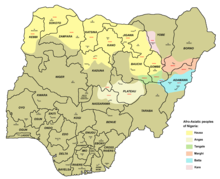Margi language
| Margi | |
|---|---|
| Native to | Nigeria |
| Region | Borno State, Adamawa State |
|
Native speakers
|
160,000 (2006) |
|
Afro-Asiatic
|
|
| Language codes | |
| ISO 639-3 | |
| Glottolog | marg1265 |

Ethnic territories of the Marghi-speaking people in Nigeria (pinkish red)
|
|
Margi, also known as Marghi and Marghi Central, is a Chadic language spoken in Nigeria. It is perhaps the best described of the Biu–Mandara branch of that family. Marghi South and Putai are closely related, and sometimes considered dialects of Margi.
Margi is noted for having a vertical vowel system, with only two vowels, /ɨ/ and /a/, in native vocabulary. (Loan words also distinguish /ɛ/ and /o/.) There are two tones, high and low, with some syllables unmarked for tone. Margi also has a large consonant inventory, with a number of labialized consonants and unusual phones such as a labiodental flap. Hoffmann (1963) describes 84 consonantal phonemes, an enormous number compared to that of most languages, equivalent to that of Ubykh as the largest inventory of any language without clicks. However, Hoffmann's list of consonants includes all onsets in the language. Many of them have since, by other researchers, been analyzed as sequences, such as /pt/ and /bz/. There are 66 consonants that remain if labialization is counted separately, 54 if it is interpreted as a /Cw/ sequence.
[ç] and [ʝ] are palatalized allophones of /x/ and /ɣ/, the latter of which is closer to an approximant [ɰ]. The closely related language Bura is similar but has a palatalized lateral series as well. /ⱱ/ is used in mimesis rather than in lexical vocabulary. The glottalized consonants /ɓ̰ ɓ̰ʷ ɗ̰/ have been described as either creaky voiced or implosive; according to Maddieson, they are evidently both, as in Hausa.
...
Wikipedia
